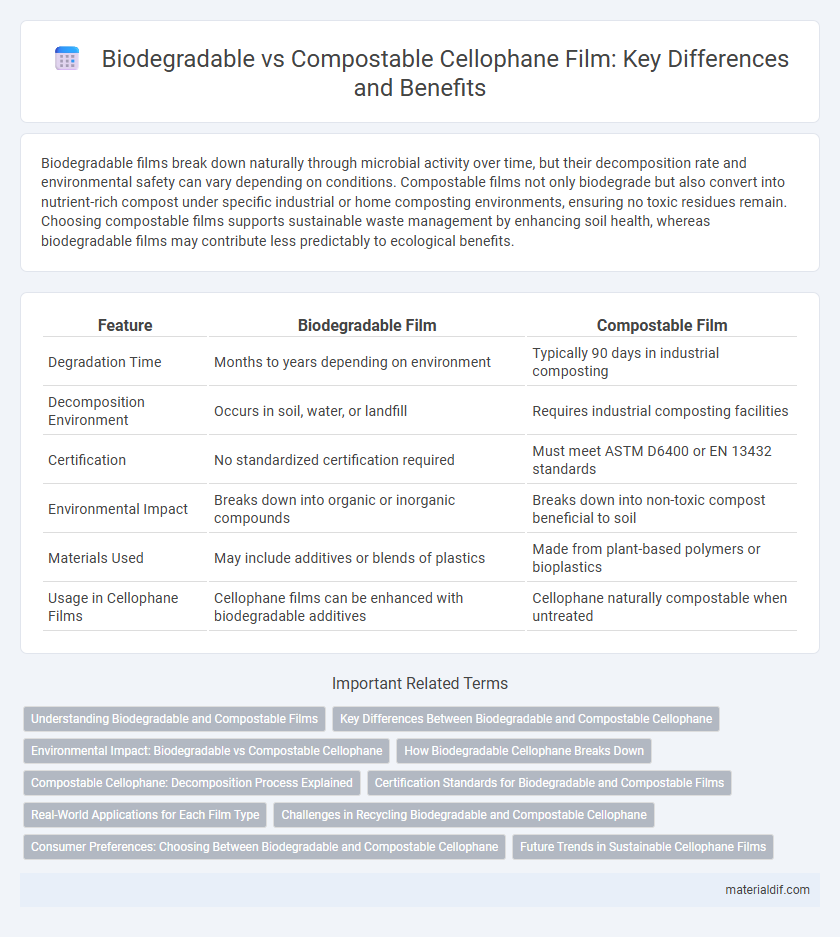Biodegradable films break down naturally through microbial activity over time, but their decomposition rate and environmental safety can vary depending on conditions. Compostable films not only biodegrade but also convert into nutrient-rich compost under specific industrial or home composting environments, ensuring no toxic residues remain. Choosing compostable films supports sustainable waste management by enhancing soil health, whereas biodegradable films may contribute less predictably to ecological benefits.
Table of Comparison
| Feature | Biodegradable Film | Compostable Film |
|---|---|---|
| Degradation Time | Months to years depending on environment | Typically 90 days in industrial composting |
| Decomposition Environment | Occurs in soil, water, or landfill | Requires industrial composting facilities |
| Certification | No standardized certification required | Must meet ASTM D6400 or EN 13432 standards |
| Environmental Impact | Breaks down into organic or inorganic compounds | Breaks down into non-toxic compost beneficial to soil |
| Materials Used | May include additives or blends of plastics | Made from plant-based polymers or bioplastics |
| Usage in Cellophane Films | Cellophane films can be enhanced with biodegradable additives | Cellophane naturally compostable when untreated |
Understanding Biodegradable and Compostable Films
Biodegradable films break down into natural elements through microbial activity within a specific time frame but may leave behind trace residues, while compostable films fully disintegrate into non-toxic components that enrich soil in a composting environment. Understanding the distinction involves recognizing that compostable films meet stricter standards, such as ASTM D6400 or EN 13432, ensuring complete biodegradation under industrial composting conditions. This differentiation is crucial for selecting sustainable packaging solutions, like cellophane films, that align with environmental goals and waste management systems.
Key Differences Between Biodegradable and Compostable Cellophane
Biodegradable cellophane breaks down naturally through microbial activity but may leave behind non-toxic residues, while compostable cellophane decomposes fully into organic matter within a specific timeframe in industrial composting conditions. Compostable films must meet strict certification standards such as ASTM D6400 or EN 13432, ensuring complete mineralization without soil or water toxicity. Biodegradable films often degrade slower and lack guarantees of eco-friendly residue, making compostable cellophane a more sustainable choice for environmentally conscious packaging.
Environmental Impact: Biodegradable vs Compostable Cellophane
Biodegradable cellophane breaks down naturally through microbial activity but may leave behind residue or microplastics, affecting soil and water quality. Compostable cellophane fully decomposes into non-toxic, organic matter within a specific timeframe under industrial composting conditions, promoting healthier ecosystems. Choosing compostable cellophane significantly reduces environmental pollution and supports sustainable waste management practices.
How Biodegradable Cellophane Breaks Down
Biodegradable cellophane breaks down through microbial activity that degrades the cellulose fibers into water, carbon dioxide, and biomass over a period of weeks to months depending on environmental conditions. Unlike compostable films that require industrial composting facilities with controlled temperature and humidity, biodegradable cellophane decomposes naturally in soil or marine environments without the need for specialized processing. This natural breakdown process reduces microplastic formation and supports soil health by returning organic matter to the ecosystem.
Compostable Cellophane: Decomposition Process Explained
Compostable cellophane breaks down through microbial activity in industrial or home composting environments, transforming into water, carbon dioxide, and biomass within 90 to 180 days. This biodegradation process requires specific conditions such as adequate moisture, temperature between 50-60degC, and oxygen availability to facilitate rapid decomposition. Unlike general biodegradable films, compostable cellophane leaves no toxic residues, ensuring environmentally safe compost that enriches soil quality.
Certification Standards for Biodegradable and Compostable Films
Biodegradable films are certified under standards such as ASTM D6400 and EN 13432, which assess the breakdown of materials within a specific timeframe in natural environments. Compostable films must meet stricter criteria, including complete biodegradation and disintegration without leaving toxic residues, verified by certifications like OK compost INDUSTRIAL and BPI Compostable certification. These certifications ensure films comply with environmental safety and performance benchmarks for biodegradation and compostability in industrial or home composting systems.
Real-World Applications for Each Film Type
Biodegradable films, including those made from cellophane, are widely used in packaging applications where gradual environmental breakdown is essential, such as food wraps and agricultural mulch films that decompose under natural conditions within months. Compostable films, certified to meet industrial or home composting standards like ASTM D6400 or EN 13432, are suitable for food service items, disposable bags, and organic waste liners that fully digest into non-toxic components in controlled composting environments. Real-world applications highlight that biodegradable films offer broad soil-based degradation advantages, while compostable films provide targeted solutions for waste management systems demanding complete compost integration.
Challenges in Recycling Biodegradable and Compostable Cellophane
Recycling biodegradable and compostable cellophane presents significant challenges due to inconsistent industrial composting infrastructure and difficulty in separating these materials from conventional plastic waste streams. Biodegradable films often require specific conditions, such as high temperature and humidity, to break down efficiently, which are not always met in standard recycling or composting facilities. Contamination from mixing with non-compostable plastics further complicates recycling efforts, reducing the overall effectiveness and sustainability of these eco-friendly films.
Consumer Preferences: Choosing Between Biodegradable and Compostable Cellophane
Consumers increasingly favor compostable cellophane films due to their ability to break down into non-toxic components in industrial composting environments within 90 to 180 days. Biodegradable cellophane films, while also environmentally friendly, degrade slower and may produce microplastics, leading to concerns over long-term soil impact. The preference for compostable options aligns with growing demand for transparent sustainability certifications and ease of disposal in zero-waste initiatives.
Future Trends in Sustainable Cellophane Films
Biodegradable films break down into natural substances through microbial activity over time, while compostable films degrade into non-toxic components within specific industrial or home composting conditions. Future trends in sustainable cellophane films emphasize enhancing compostability standards and incorporating bio-based materials to improve environmental impact and performance. Innovations include embedding enzymes for faster degradation and developing agronomically sourced cellulose to increase renewability and circular economy potential.
Biodegradable Film vs Compostable Film Infographic

 materialdif.com
materialdif.com